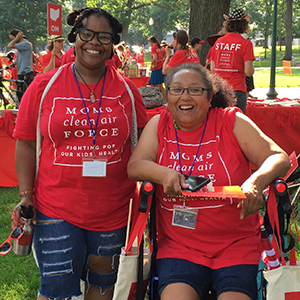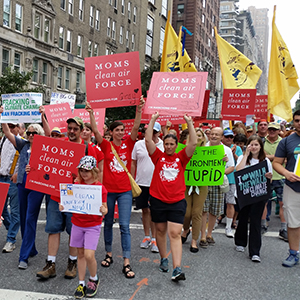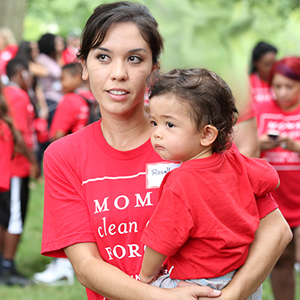Full text
Este recurso ha sido verificado por expertos en políticas, utilizando las últimas investigaciones científicas. Encuentre todas nuestras fuentes en los enlaces a continuación.
¿Qué es la contaminación del aire?
La contaminación del aire es la liberación al aire de toxinas y contaminantes, los cuales son dañinos para la salud humana y el medio ambiente. El respirar aire contaminado puede ser especialmente dañino para los niños.
La contaminación del aire puede originarse fuera o dentro de su casa. La contaminación del aire puede consistir en partículas diminutas, ozono a nivel de suelo, smog, humo, gas, emisiones de diésel, sustancias químicas tóxicas y más. Las fuentes de contaminación externas al hogar incluyen plantas de energía, automóviles, camiones, hidrofracturación, refinerías, fábricas, incineradores, actividades agrícolas, pesticidas e incendios forestales. Las fuentes de contaminación del aire dentro del hogar incluyen el moho y productos que contengan sustancias químicas tóxicas.1
¿De qué manera la contaminación del aire afecta la salud?
La mala calidad del aire puede dañar la salud humana.2 Los niños son especialmente vulnerables ante los efectos de la contaminación del aire, ya que sus pulmones y demás órganos todavía están en desarrollo.3 Otros grupos vulnerables incluyen a personas embarazadas, personas mayores, personas que trabajan al aire libre y personas con enfermedades subyacentes.4
Según la fuente de contaminación, los impactos sobre la salud pueden incluir: ataques de asma, infecciones respiratorias y otros trastornos respiratorios; problemas en recién nacidos, como parto prematuro, bajo peso al nacer y malformaciones congénitas; ataques cardíacos y derrames cerebrales; problemas neurológicos y de desarrollo; cáncer de pulmón; depresión y otros problemas de salud mental; y mayor riesgo de muerte prematura.
¿Por qué los latinos deberían preocuparse?
Aproximadamente 10 millones de latinos viven en condados con bajas calificaciones en las mediciones de ozono y la contaminación por partículas.5
Más de un tercio de los latinos en los Estados Unidos (más de 23 millones de personas) viven en condados donde el aire no cumple con las normas de salud pública referentes al smog.6
3.3 millones de latinos en los Estados Unidos viven a menos de una milla de distancia de plantas de gas y petróleo activas, las cuales pueden emitir mucha contaminación al aire.7
En 2018, 2.3 millones de latinos en los Estados Unidos reportaron haber sufrido de asma, condición que puede empeorar a causa de la contaminación del aire. Los latinos tienen una doble propensidad en comparación a los blancos no hispanos a recurrir a salas de emergencia a causa del asma.8
Nota sobre el lenguaje: Si bien hay un traslape significativo entre los términos «latino» e «hispano», no son exactamente lo mismo. La manera en que las personas latinas e hispanas se describen a sí mismas no es universal ni estática. Aquí, el término «hispano» se usa para citar investigaciones específicas que emplean dicho término. «Latino» se usa en todos los demás casos.
What is air pollution?
Air pollution is the release of toxins and contaminants into the air that are harmful to human health and the environment. Breathing polluted air can be especially harmful for children.
Where does air pollution come from?
Air pollution can come from outside and inside your home. Air pollution can take the form of tiny particles, ground level ozone, smog, smoke, gas, diesel emissions, toxic chemicals, and more. Outside sources include power plants, cars, trucks, fracking, refineries, factories, incinerators, agriculture, pesticides, and wildfires. Inside sources of air pollution include mold and products containing toxic chemicals.1
How does air pollution affect our health?
Poor air quality can harm human health.2 Children are especially vulnerable to the health impacts of air pollution, because their lungs and other organs are still developing.3 Other vulnerable groups include pregnant people, the elderly, outdoor workers, and people with underlying medical conditions.4
Depending on the source of pollution, resulting health impacts can include: asthma attacks, respiratory infections, and other respiratory disorders; adverse birth outcomes, including premature birth, low birth weight, and birth defects; heart attacks and strokes; neurological and developmental problems; lung cancer; depression and other mental health challenges; and an increased risk of premature death.
Why should Latinos care?
Nearly 10 million Hispanics live in counties that received failing grades on ozone or particulate pollution measures.5
More than 1/3 of US Latinos—over 23 million— live in counties where the air doesn’t meet public health standards for smog.6
3.3 million US Hispanics live within one mile of active oil and gas facilities, which can emit significant amounts of air pollution.7
In 2018, 2.3 million US Hispanics reported suffering from asthma, which can be exacerbated by air pollution. Hispanic people are twice as likely to visit the emergency room for asthma than non-Hispanic white people.8
What can we do?
JOIN our efforts to educate, engage and empower members of your community to take action.
HOST a “cafecito” with your family and friends to help them learn more about air pollution in your community.
LEARN more about the air quality in your community. Visit the website
www.airnow.gov for information about your air.
CONTACT local, state, and federal officials asking them to take bold leadership to clean up the air. Sign a petition to take action.
A note on language: Though there is strong overlap between the terms “Latino” and “Hispanic,” they are not exactly the same, and the way that Latino and Hispanic individuals describe themselves is not universal or static. Here, the term “Hispanic” is used when citing specific research that uses this term. “Latino” is used in all other circumstances.
Sources: momscleanairforce.org/sources-latinos-air-pollution
Enlaces y fuentes: momscleanairforce.org/sources-latinos-air-pollution





